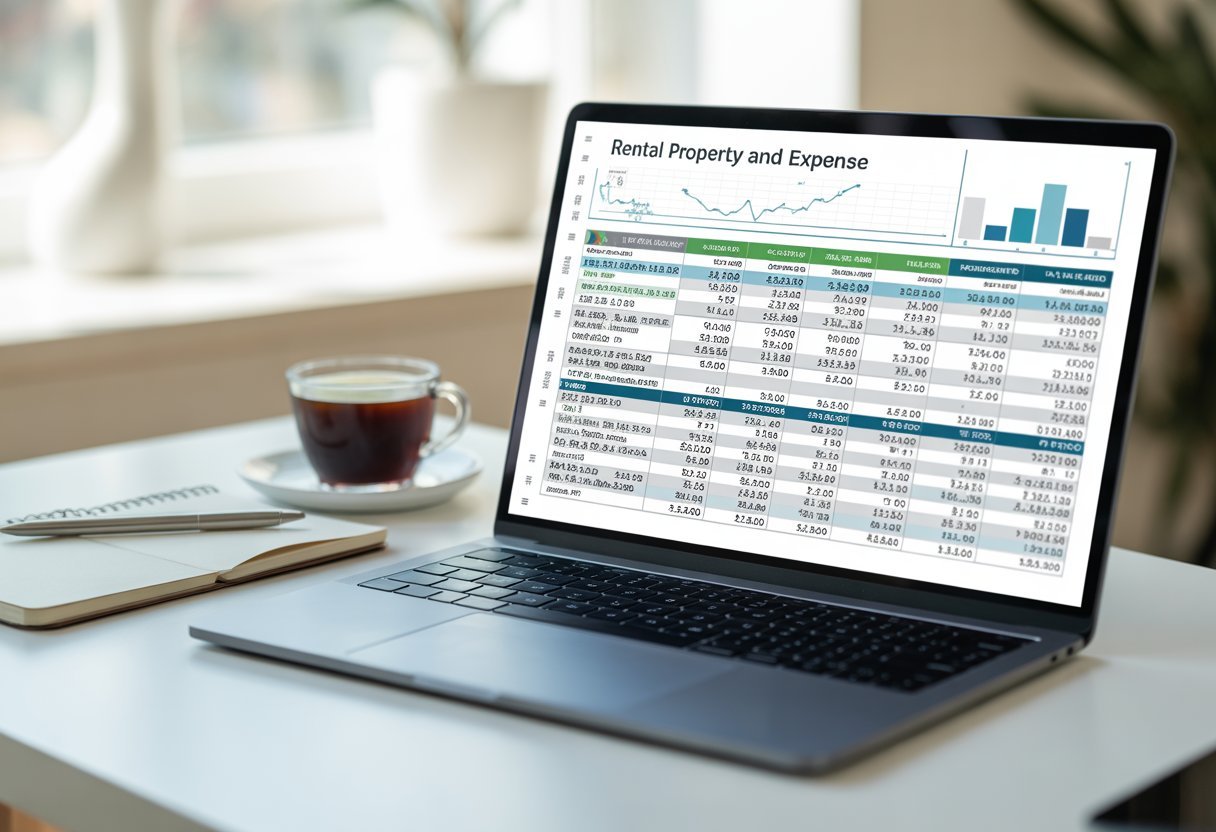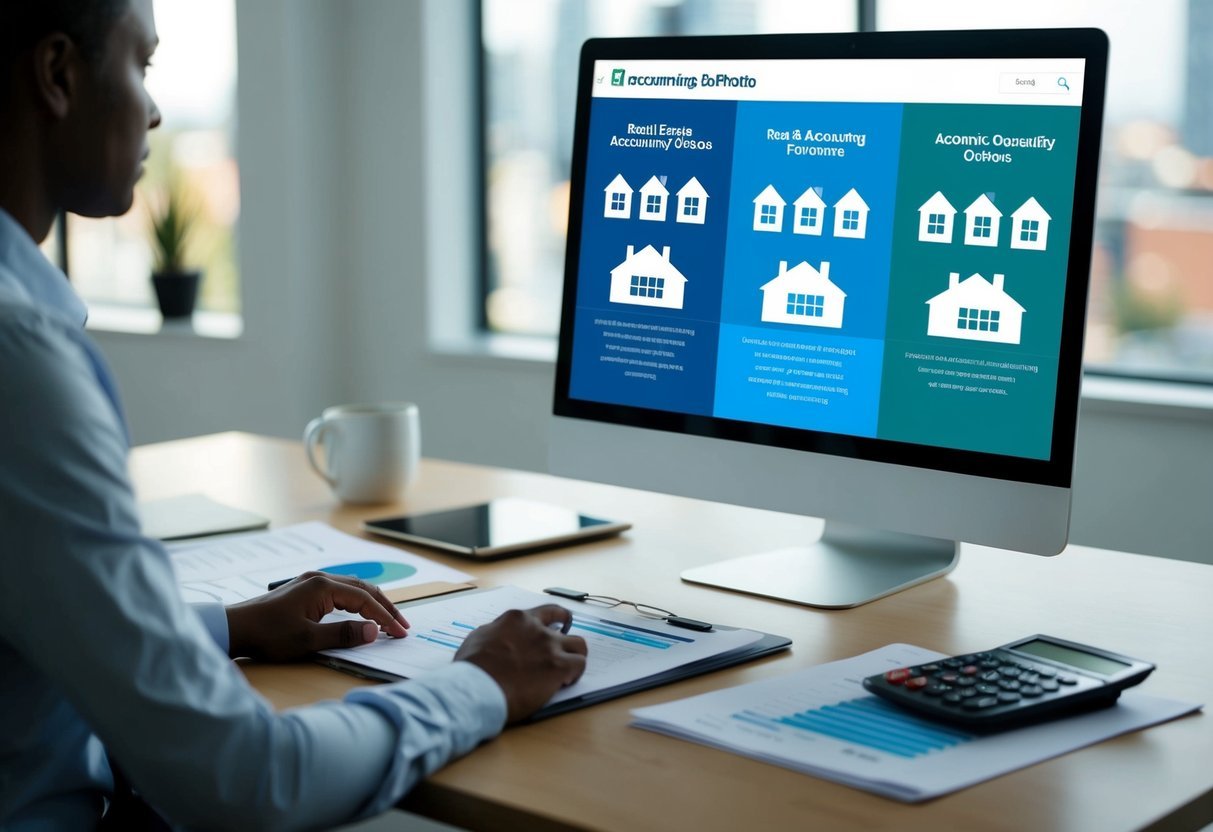Managing rental properties requires meticulous record-keeping and financial tracking to maximize profitability. Using rental property spreadsheet templates can help you organize income, expenses, and key metrics while saving time and reducing errors in your property management process.
Proper tracking systems allow you to make data-driven decisions about your rental investments. Whether you own a single property or manage multiple units, customizable templates provide the structure needed to monitor cash flow, track maintenance costs, and analyze overall property performance.
These essential spreadsheet trackers transform complex property management tasks into organized, actionable data. You can easily customize free worksheet templates to match your specific needs while maintaining professional-grade financial records for tax purposes and investment analysis.
Key Takeaways
- Spreadsheet templates streamline rental property financial management and record-keeping
- Customizable trackers help monitor cash flow, expenses, and maintenance costs
- Professional templates ensure accuracy when manually entering data for tax reporting and investment analysis
Essential Features of Rental Property Spreadsheet Templates
A well-designed rental property spreadsheet template enables accurate financial tracking, simplified property management, and automated calculations to save time and reduce errors.
Template Types
Rental property spreadsheet templates come in formats compatible with both Excel and Google Sheets. Single-property templates work best for landlords with one rental unit, while multi-property versions allow tracking numerous properties in one workbook.
Basic templates focus solely on income and expenses, perfect for beginners or small-scale operations.
Comprehensive templates include additional worksheets for tenant information, maintenance schedules, and property analysis tools.
Customizable Fields
Your rental property tracking spreadsheet should include fields for:
- Property address and purchase information
- Monthly rent collection dates and amounts
- Tenant contact details and lease terms
- Maintenance and repair costs
- Insurance and property tax expenses
- Mortgage payments and loan terms
- Utility bills and HOA fees
These fields should be easy to modify to match your specific property management needs.
Automated Calculations
Professional spreadsheet templates feature built-in formulas to calculate:
- Net Operating Income (NOI)
- Cash flow analysis
- Return on Investment (ROI)
- Vacancy rates
- Year-end profit and loss statements
Automatic data validation helps prevent entry errors and ensures accurate financial reporting.
Monthly and annual summaries update automatically as you input new data, saving time on manual calculations.
Tracking Rental Income and Expenses
Proper financial tracking helps maximize your rental property returns while simplifying tax preparation. Free spreadsheet templates streamline the process of monitoring cash flow and expenses.
Recording Rental Income
Track each payment with the date received, property address, tenant name, and payment amount. Create separate columns for monthly rent, late fees, security deposits, and other income types.
Digital worksheets automatically calculate your total rental income and alert you to late or missing payments.
Set up automatic rent collection through property management software to reduce manual data entry and prevent payment recording errors.
Expense Tracker Templates
Expense tracking spreadsheets should include categories like:
- Maintenance and repairs
- Property management fees
- Insurance premiums
- Property taxes
- Utilities
- Mortgage payments
Create separate columns for the date, vendor, payment method, and receipt documentation.
Break down expenses by property to analyze profitability of individual units.
Statements and Reporting
Generate monthly financial statements to review your rental property performance. Include key metrics like:
- Net operating income
- Expense ratios
- Vacancy rates
- Cash flow analysis
Income and expense worksheets help organize data for tax reporting and Schedule E preparation.
Review statements quarterly to identify cost-saving opportunities and adjust rental rates based on market conditions.
Analyzing Cash Flow and Profitability
Accurate financial analysis helps determine if a rental property will generate positive returns. A detailed spreadsheet tracks income streams, operating expenses, and key profitability metrics to guide investment decisions.
Cash Flow Analysis
The rental property cash flow analysis spreadsheet tracks monthly income and expenses to calculate net cash flow. Start by entering your rental income, including monthly rent payments and other fees.
List all operating expenses like:
- Property taxes
- Insurance
- Utilities
- Maintenance costs
- Property management fees
- Mortgage payments
Your cash flow is the difference between total income and expenses. A positive cash flow indicates the property generates more money than it costs to operate.
Annual Cash Flow
Track your yearly rental property performance by analyzing annual cash flows. This broader view reveals seasonal patterns and long-term profitability trends.
Calculate annual figures for:
- Total rental income
- Vacancy losses
- Operating expenses
- Debt service
- Capital expenditures
Remember to factor in irregular expenses like major repairs or upgrades that affect annual returns.
Net Operating Income
Net Operating Income (NOI) measures property performance before mortgage payments and taxes. Calculate NOI by subtracting operating expenses from gross rental income.
Key components of NOI:
- Gross Potential Rent: Maximum possible rental income
- Effective Gross Income: Actual rent collected minus vacancies
- Operating Expenses: All costs except mortgage and income taxes
Use NOI to compare properties and determine capitalization rates by dividing NOI by property value.
Property Valuation and Investment Metrics
Accurate financial metrics help determine the true value and potential profitability of rental properties. These calculations reveal whether a property will meet your investment goals and generate positive returns.
Cap Rate Calculations
The capitalization rate measures a property’s potential return regardless of financing. To calculate cap rate, divide the net operating income (NOI) by the property’s market value and multiply by 100.
Cap Rate = (NOI ÷ Property Value) × 100
A rental property analysis spreadsheet can automatically calculate this key metric. Good cap rates typically range from 4-10%, depending on the market and property type.
The NOI factors in:
- Gross rental income
- Other income (parking, laundry, etc.)
- Operating expenses
- Vacancy rates
- Property management fees
Cash-on-Cash Return
Cash-on-cash return measures the cash income earned relative to the cash invested in a property. This metric helps you evaluate the actual cash flow performance of your investment.
The formula is: Annual Pre-Tax Cash Flow ÷ Total Cash Invested × 100
Your property analysis tools should track:
- Down payment
- Closing costs
- Repair costs
- Annual mortgage payments
- Net cash flow
A cash-on-cash return above 8-12% typically indicates a strong investment opportunity.
ROI & Investment Analysis
Return on Investment (ROI) provides a comprehensive view of your property’s total return, including appreciation and tax benefits.
Key ROI components include:
- Equity buildup: Principal reduction through tenant rent payments
- Property appreciation: Historical market value increases
- Tax advantages: Depreciation deductions and write-offs
- Cash flow: Monthly rental income minus expenses
Use investment analysis spreadsheets to project 5-year and 10-year ROI scenarios. Consider both conservative and optimistic appreciation rates when forecasting future returns.
Set target ROI thresholds based on your investment strategy and risk tolerance. Most investors aim for 15-20% annual ROI including all return components.
Budgeting and Planning for Rentals
A detailed budget and tax plan forms the foundation of profitable rental property investing. Proper tracking tools help maximize returns while minimizing tax liability.
Budget Templates
Free budget worksheets help you track all income and expenses systematically. Your template should include categories for mortgage payments, insurance, utilities, repairs, and property management fees.
Create separate worksheets for each property to monitor individual performance. Track both fixed costs like loan payments and variable expenses such as maintenance.
Include columns for actual versus projected numbers to identify variances. This helps refine future budgets and catch potential issues early.
Digital spreadsheet tools offer automated calculations and customizable formats. Many include pre-built formulas for key metrics like cash flow and ROI.
Tracking Property Taxes
Property tax tracking requires meticulous record-keeping throughout the year. Save assessment notices, payment receipts, and related correspondence.
Create a calendar with important tax deadlines and payment due dates. Many jurisdictions offer early payment discounts you can take advantage of.
Your expense tracking system should separate property taxes from other costs. This makes tax season easier and helps identify opportunities for assessment appeals.
Consider setting up monthly escrow payments to avoid large annual tax bills. Review assessments annually to ensure they accurately reflect your property’s value.
Leveraging Spreadsheet Templates for Different Types of Rentals
Excel spreadsheet templates help streamline financial tracking and analysis across various rental property types. You can customize these templates to match your specific rental business needs while maintaining accurate records of income and expenses.
Short-Term Rentals
Short-term rental properties require detailed tracking of daily rates, cleaning fees, and occupancy patterns. Create separate columns in your spreadsheet to monitor seasonal pricing fluctuations and dynamic rates.
Track your rental income by logging nightly rates, booking fees, and additional services like pet fees or extra guest charges. Include columns for:
- Cleaning costs per turnover
- Utility expenses by stay
- Platform commission fees
- Supply restocking costs
Set up automated calculations to determine your average daily rate and revenue per available room (RevPAR).
Managing Multiple Rental Properties
When handling several properties, organize your rental property analysis spreadsheet with separate tabs for each location. Track individual property performance while maintaining consolidated financial reports.
Create a master dashboard that displays:
- Total monthly rental income
- Aggregated expenses by category
- Vacancy rates across properties
- Net operating income per unit
Include property-specific identifiers and use color coding to quickly distinguish between different rental units. Set up formulas to calculate cash-on-cash returns and capitalization rates for your entire portfolio.
Advanced Financial Analysis Tools in Rental Property Spreadsheets

Modern rental property spreadsheets integrate sophisticated financial metrics to help you make data-driven investment decisions. Advanced analysis tools transform raw data into actionable insights for evaluating potential returns.
NPV and IRR Calculations
Net Present Value (NPV) measures the profitability of your rental property investment by calculating the current value of all future cash flows. You’ll want to target properties with a positive NPV, indicating the investment’s worth exceeds its costs.
Internal Rate of Return (IRR) shows your investment’s annual growth rate. A higher IRR suggests better returns compared to alternative investments. Rental property spreadsheets can automatically calculate these metrics when you input:
- Purchase price and closing costs
- Expected rental income
- Operating expenses
- Projected property appreciation
- Planned holding period
Discounted Cash Flow (DCF)
DCF analysis helps you determine a property’s current value based on expected future income. This tool accounts for the time value of money by applying a discount rate to future cash flows.
Your DCF calculations should include:
- Annual rental income growth projections
- Vacancy rate estimates
- Maintenance and repair costs
- Property tax increases
- Insurance premium adjustments
Advanced spreadsheet templates can factor in varying debt scenarios, including different loan terms and interest rates, to show how financing affects your returns.
Frequently Asked Questions
Managing rental property finances requires accurate tracking of income, expenses, and key metrics. The right spreadsheet template helps streamline data organization and analysis for better property management decisions.
What are the essential elements to include in a rental property expense spreadsheet?
Your rental property spreadsheet must track monthly rent payments, security deposits, and lease terms for each unit.
Include categories for maintenance costs, property taxes, insurance, utilities, mortgage payments, and property management fees.
Create separate columns for tracking vacancy rates, late payments, and tenant communication records to maintain comprehensive financial oversight.
How can I create a rental property spreadsheet in Google Sheets?
Start with a blank Google Sheet and create separate tabs for income tracking, expense logging, and property details.
Set up formulas to calculate monthly cash flow, return on investment (ROI), and cap rates automatically.
Add data validation rules to ensure consistent input and create dropdown menus for common expense categories.
What templates are available for managing rental property finances in Excel?
Professional property management templates include customizable spreadsheets for tracking multiple properties and units.
Free rental property spreadsheets offer basic layouts for monitoring income and expenses.
Excel templates typically include built-in calculations for key metrics like net operating income and cash-on-cash returns.
How do I track rental income and expenses for my properties effectively?
Record all transactions immediately using dedicated columns for different income sources and expense categories.
Maintain separate worksheets for each property while using a master sheet to aggregate financial data.
Use color coding and conditional formatting to highlight overdue payments and upcoming maintenance schedules.
Are there free rental property management templates available for Excel?
Property rental manager spreadsheets offer free solutions for basic property management needs.
Many templates include features for tracking tenant information, lease agreements, and maintenance requests alongside financial data.
Create custom reports by modifying existing free templates to match your specific property management requirements.
What is the best way to organize rental property financial records in a spreadsheet?
Structure your spreadsheet with monthly tabs for detailed transaction tracking and an annual summary sheet.
Create automated dashboards to display key performance indicators like occupancy rates and profit margins.
Back up your spreadsheet regularly and maintain digital copies of all supporting documents linked to relevant entries.



